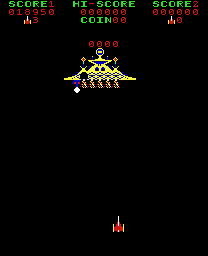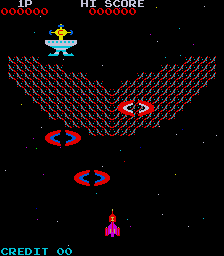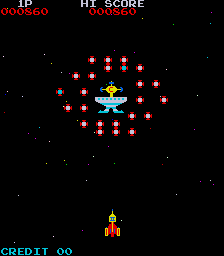In 1980 and 1981, as part of the rush to improve on the shoot 'em up formula pioneered by Space Invaders and Galaxian, a number of arcade games started including "boss" stages, where the player must defeat a single opponent in order to advance. These opponents are often be accompanied by other enemies, but only the primary character needs to be defeated. Phoenix (1980) is generally credited with being the first to feature such an enemy in an action game, and several other games released in the following two years would include boss-like battles. Let's look at the different approaches they took in designing these battles.
One-Hit Wonders
Early bosses varied greatly in their complexity, with some requiring you to break through multiple barriers and others requiring only one well-placed shot. The latter approach is exemplified by
Destroyer, the first release by a Spanish arcade game company called Cidelsa (I previously discussed them in the context of
unfixed shooters).
Destroyer is a simple shoot 'em up, with the player fighting off multiple waves of enemies from a position at the bottom of the screen. After five waves of enemies, the player is presented with this character.
The boss tries to crush you, but is easily dispatched with a single well-placed and well-timed shot at its head, where an opening reveals an apparent weak point. The battle is typically very short, as the player just needs to keep firing vertically until a shot lands, and the boss doesn't fire any bullets of its own. The lack of buildup and relative simplicity of the battle make for a forgettable experience.
Similarly, in
Super Astro Fighter, the player confronts a boss with almost identical mechanics.
Super Astro Fighter is a sequel to
Astro Fighter,
one of the first shoot 'em ups to be released in the year following
Space Invaders. After five waves of smaller enemies, the player faces off against a large insectoid creature.
Instead of blinking in and out, the boss opens and closes its mouth to reveal its weak point, but from the gameplay point of view, it's the same thing as in Destroyer.
In this case, the boss battle also doubles as a refuel point. By 1981, limiting the player's fuel had become a popular game mechanic because it encouraged the player to dispatch enemies quickly. Many previous games, like
Invader's Revenge, had required players to dock at a space station to replace their fuel. Given that these docking events typically occurred at the end of several waves of enemy attacks, they could be considered predecessors to the boss battle.
Not all one-hit bosses were throwaways.
Sasuke vs. Commander (1980, SNK), a fixed shooter masquerading as a series of martial arts battles, confronts the player with a miniboss in every other stage. The first few minibosses (i.e., "commanders") are dispatched with a single hit, but each battle is designed differently. In the first one, you have to run continuously to avoid vertical blasts of fire, and the only way to hit the boss is to shoot while on the run, just as he stops to fire at you. The second miniboss uses the doppelganger attack, where he creates phantasmal copies of himself and forces the player to guess which one is real. It's likely that this is the first such instance of the technique in video games.
Piece-by-Piece
One obvious way to step up the complexity in a boss battle is to require the player to destroy different parts of the boss, one at a time. In Astro Fantasia (1981, Data East), four well-placed shots are required to dispatch the boss; one at each wing, one at the bottom center, and then a final one at the top center.
The boss's movements are very simple -- side-to-side bouncing followed by a jittery descent -- but it still feels like a more complete battle than the one-hit bosses. It's not clear why the the boss partially regenerates in its final descent, but the mechanics are simple enough that it’s easy to figure out what to do.
Not all of the multi-hit bosses are so straightforward. Another battle that takes a piecemeal approach is Centuri's 1981 follow-up to Phoenix, Pleiades. Here, the player is confronted with a mothership with flames coming out of the bottom.
Every now and then, a panel in the mothership opens, releasing enemies that immediately attack you. If you shoot a panel while it's open, the flame that's under it will disappear. If you extinguish all of the flames, the boss is defeated, but the central panel won’t open unless you've defeated enough smaller enemies and the boss changes color. However, the boss will also self-destruct if you’ve defeated all of the enemies that were inside, but that's hard to keep track of because you're also being attacked by enemies from the side.
Deducing these rules was not easy, and in practice, an approach of shooting everything that moves will eventually work. You can actually destroy the mothership without landing a single shot on it, which is just bizarre and almost defeats the purpose of the boss. The developers should have put more thought into the mechanics of this battle because it feels a bit like fighting a black box.
Whittling Away...
Of the boss battles that appear in early fixed shooters, the longest and most complete are those that include shielding of some kind. For one example, I refer you to the mother of all shoot ‘em up bosses, the Phoenix mothership.
Look at the shield and compare to the original
Space Invaders, where the player is protected by bunkers that get gradually eaten away by enemy fire.
Phoenix uses the same concept, but with the bunker around the boss instead of the player. Of course, they're not going to let you fire away at the shield unmolested. Diving birds and the boss himself take regular potshots at the player, and a rotating conveyor provides yet another obstacle before you can finally finish off the boss.
Unlike in the bosses mentioned previously, the design of the Phoenix boss actually lends itself to strategic considerations. Do you just focus your fire on the part of the shielding in front of the boss, or do you first damage the conveyor belt from the side, where the enemy fire is less intense? How much time do you spend dispatching the birds and is it worth trying to pick some of them off from the sides? By allowing multiple strategies, the game becomes more replayable
Similar considerations arise in the boss battle of
Gorf.
Here, the shield is a less substantial hindrance than it was in Phoenix, but that doesn't mean that the battle is easier. Theoretically, you could finish the level with two well-placed shots; one through the shield and another in the boss' vulnerable point.
 |
| Vulnerable point of the Gorf boss. |
Good luck, however, hitting a one-pixel-wide gap while under pressure from both the ship’s fire and the diving aliens. And if you miss, a piece of the ship will "fall" in your direction.
You'll probably need at least 5 - 10 clean shots on the boss before you manage to squeak one in through that hole, so it ends up being of similar duration to the boss battle in Phoenix. The primary strategic consideration is where to shoot from. You can get up close and try to improve your aim on the boss, but that will give you less time (and space) to dodge incoming fire.
But as well designed as are Gorf and Phoenix, my favorite boss in a fixed shooter is from an obscure arcade game called Black Hole (1980, Game-a-Tron).
Much like in Phoenix, there is a shield that you can whittle away and which gradually descends on you. However, instead of facing enemy fire, you're pitted against a swarm of what appear to be hungry pairs of parentheses. Actually, you can infer from the game's title that they're meant to be black holes... but don't expect them to act like black holes.
If you shoot the "black holes", they open up, allowing you to pass through them and accumulate points. They close quickly, so don't shoot them too soon. The black holes will move in your direction, but only change course at specific inflection points, so with a little practice, you should be able to direct them out of harm's way while you're firing at the shield. Once you've broken through the shield, be aware that firing at the boss will not destroy it, but will instead hasten the advancement of the shield. This can be good if you've cleared a wide enough path in front of you, but if you haven't, you could get smushed.
And that's not even the end. Once you're clear of the shield, a final showdown commences.
The boss is now wrapped in orbs which can deflect your shots. He'll never fire at you, but avoiding his bouncing cocoon of orbs, not to mention your own shots, is challenge enough. In some cases, your shots may bounce around several times before exiting the cocoon, so be careful.
The orbs rotate in two concentric shells, and the boss can only be hit when the shells align and leave gaps between the orbs. Two well-placed shots between the orbs will dispatch your foe and end the round.
Considering the obscurity of both game and developer, Black Hole contains a surprising amount of depth. Learning to manage the black holes is the most challenging problem, because you need to decide when to shoot them, when to pass through them, and how to guide their movements. This is on top of choosing where to focus your fire; if you create too narrow a path in the shield, you may get trapped by the black holes.
Looking Forward
We don't generally associate fixed shooters with boss battles, in large part because they flourished in an era when the "boss" wasn't a well-established video game concept and developers were still experimenting with the mechanics. Starting in late 1981, scrolling shooters would begin to dominate fixed shooters at the arcades, and the art of the shoot em up boss would continue there.
Nevertheless, some of the ideas used in these early fixed shooters would stick around, notably the piece-by-piece knockdown and the doppleganger attack. On the other hand, the Space-Invaders-style shield has gradually disappeared, probably because it takes up so much space on the screen. Later games would use damage meters or gradual color changes to give a visual indication of a player's progress.











Nice post!
ReplyDelete